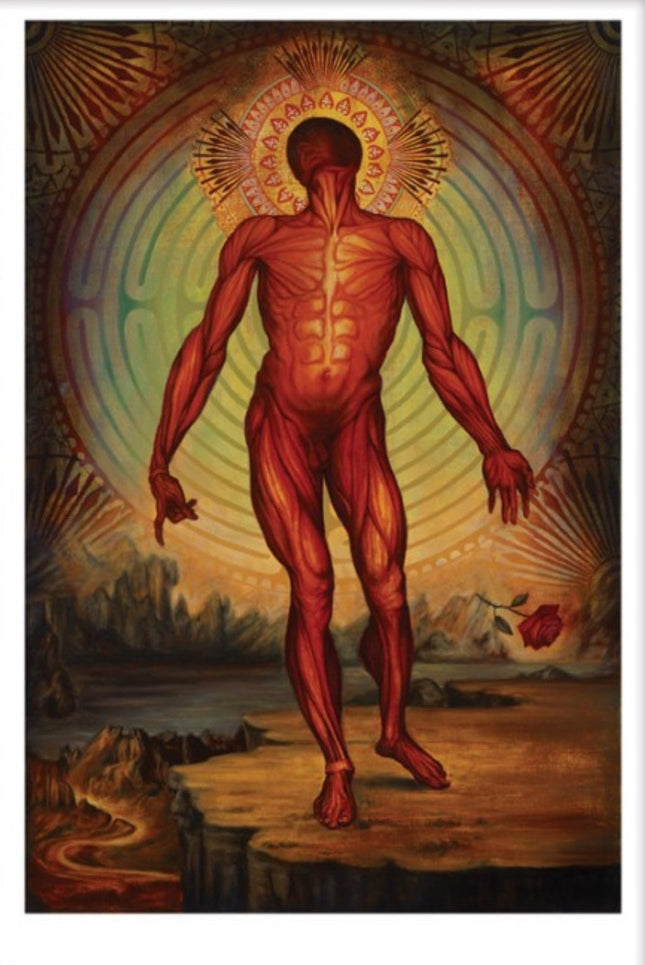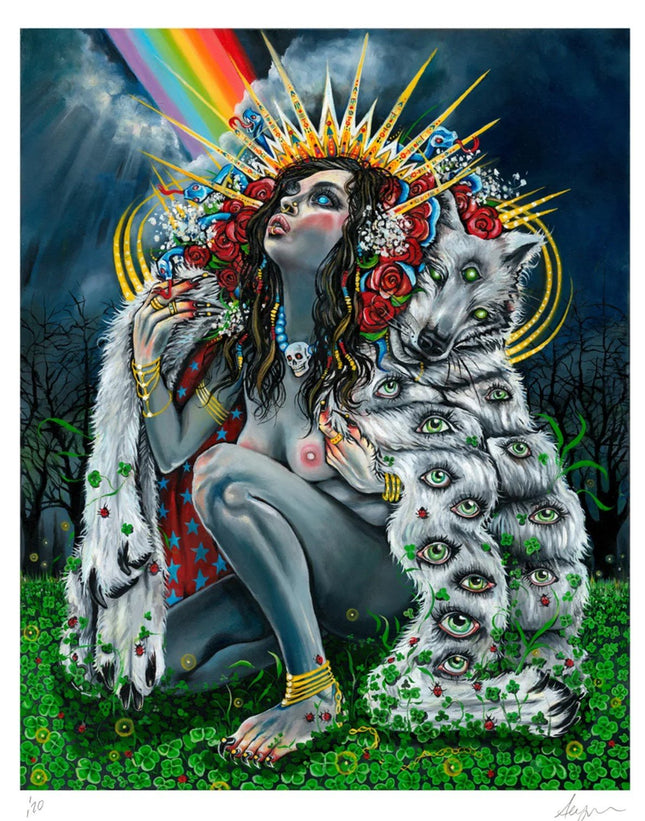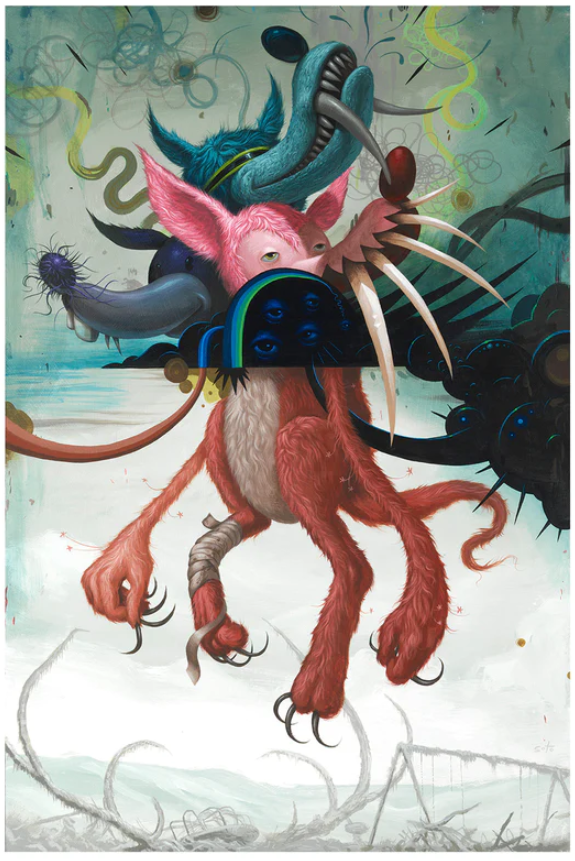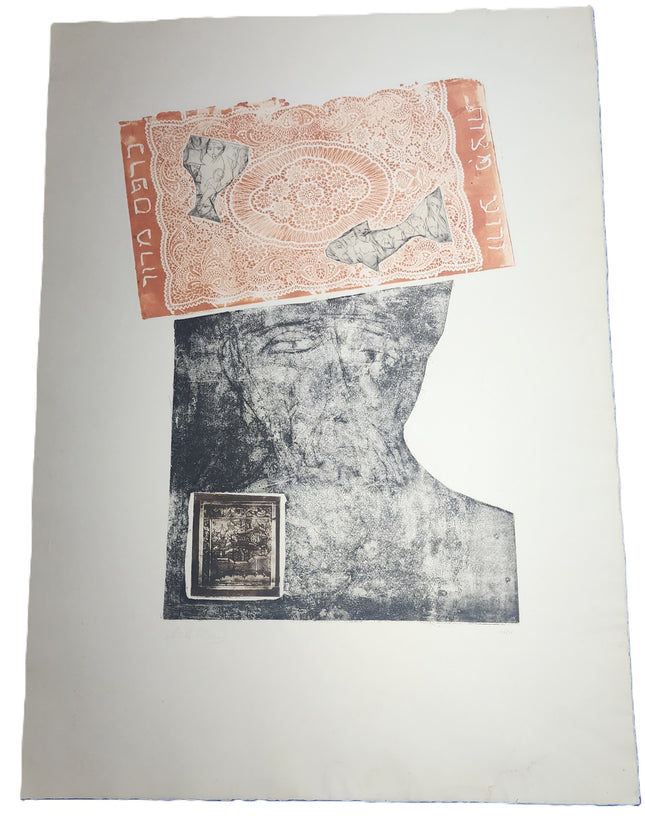
Tribal Druid & Native
-

Beau Stanton The Fool Archival Print by Beau Stanton
The Fool Limited Edition Archival Pigment Print on 310gsm Fine Art Paper by Beau Stanton Graffiti Street Artist Modern Pop Art. "The Fool was the central piece from my Arcane Archetypes exhibition where all the paintings were based on images from the Major Arcana of the Tarot. My first intention with this body of work was to create a series of images that instill a lasting imprint into the viewer’s subconscious. As an initial point of departure I started to research one of the most recognizable and iconic sets of images, the Major Arcana of the Tarot. After studying several existing decks, I discovered that some of the images shared common ground visually and conceptually with several paintings I had created in the past.When I first thought about making a series of paintings based on images from the Tarot, I knew that I would have to include the Fool since it is the “zero” card and an extremely important archetype in the set. I started by researching all of the iconic tarot decks to see the ways the symbols had been interpreted in the past along with reading a few books by 19th Century occultists who were really into tarot. From there I applied some of my own symbols that I often use in my work that had common ground with the overall significance of The Fool to concoct a fresh take on an ancient iconic symbol." - Beau Stanton
$330.00
-

Alexis Price After The Storm Giclee Print by Alexis Price
After The Storm Giclee Fine Art Limited Edition Print on Fine Art Paper by Modern Pop Artist Alexis Price. 2019 Signed & Numbered 24x30 Edition of 20
$450.00
-

Jeff Soto Broken Lithograph Print by Jeff Soto
Broken Lithograph Print by Jeff Soto Hand-Pulled Print on 80# Patina Matte Fine Art Paper Limited Edition Graffiti Street Pop Artwork. 2010 Signed & Numbered Limited Edition of 450 Artwork Size 21.88x30 Jeff Soto's "Broken" Lithograph: A Tapestry of Street Pop Art and Surrealism Jeff Soto's "Broken" lithograph is a masterful amalgamation of graffiti's raw spontaneity and the vivid, dream-like quality of pop art, presenting a unique tableau that captures the imagination. This hand-pulled print on 80# Patina Matte Fine Art Paper, released in a limited edition of 450 in 2010, is a testament to Soto's prowess in translating the essence of street art onto a more enduring medium. Each piece, sized at 21.88x30 inches, is meticulously signed and numbered, emphasizing its exclusivity and the artist's personal touch. Soto's work is renowned for its intricate detail, and "Broken" is no exception, with its layered imagery and textured visuals that invite viewers to delve into a narrative as sprawling and complex as graffiti itself. "Broken" is not just an artwork; it is a narrative piece that encapsulates the multifaceted nature of Street Pop Art and Graffiti Artwork. The fantastical creature at the center of the composition, with its vibrant pink hue and juxtaposition of animalistic traits, is a visual anchor that draws the eye and ignites curiosity. This creature, existing in a world that defies conventional reality, symbolizes the freedom of expression inherent in street art. This freedom allows for a fusion of the real and the surreal, giving rise to a new realm where the rules of traditional art are bent and reimagined. The Cultural Impact of Jeff Soto's "Broken" in the Art World Jeff Soto's "Broken" cultural impact extends beyond its aesthetic appeal, speaking to the heart of the street art movement's influence on contemporary art. The piece embodies the rebellious spirit of graffiti, with its disregard for boundaries and its challenge to the status quo. In bringing such a piece to the realm of fine art prints, Soto demonstrates the evolving perception of graffiti as a legitimate and impactful form of artistic expression. The limited edition nature of "Broken" mirrors the transient nature of street murals, often at the mercy of time and urban development, adding a sense of preciousness to their ownership. Soto's "Broken" celebrates the creative spirit that drives the street pop art movement. It bridges the often underground world of graffiti and the established art community, showcasing the potential for street-inspired visuals to resonate within gallery spaces. The print's complexity, with its swirling colors and forms, echoes the layered textures and meanings often found in street murals, inviting a deeper engagement and interpretation from its audience. Jeff Soto's "Broken" lithograph print is a vibrant homage to the transformative power of street pop art and graffiti. As a limited edition work, it captures the essence of a movement that continues to challenge and redefine the boundaries of artistic expression. Each signed and numbered print stands as a testament to the artist's vision, a piece of a larger narrative that celebrates the union of street culture and fine art. Much like the street art inspired by, it is a narrative that continues to evolve and influence long after the paint has dried.
$206.00
-

Zwy Milshtein Three-Piece Etching Aquatint Print by Zwy Milshtein
Three-Piece Etching Limited Edition Etching with Aquatint Print on Hand-Decorated Fine Art Paper by Zwy Milshtein is a pop art graffiti artist art. 1970 Signed & Numbered Limited Edition Etching Art Print. Artist: Zwy Milshtein Title: Three Piece Etching Medium: etching, with Aquatint Size: 21 x 30 inches Edition: Signed in pencil and marked 26/75 Zwy Milshtein: A Maestro of Etching and Aquatint Zwy Milshtein's artistic narrative is one of movement, not just across geographies but also through the evolution of his distinct style and technique. Born in 1934 in Kichinev, now known as Moldova, Milshtein's journey through the turbulence of World War II led him from Russia to Romania and eventually to Israel. However, in Paris, to which he moved in 1955, Milshtein found his enduring artistic home. Here, he became renowned as both a painter and a master engraver, celebrated for his etchings and engravings that capture the complexity of human experience. The Intertwining Paths of Engraving and Street Art The "Three-Piece Etching" by Milshtein is a testament to the craftsmanship and depth of engraving as an art form. Completed in 1970, this signed and numbered limited edition etching with aquatint, measuring 21 x 30 inches, is a fine example of Milshtein's adeptness with aquatint—a technique that allows for the creation of tonal effects, producing rich textures and a range of shades that lend a painterly quality to prints. This artwork, part of an exclusive series marked 26/75, is particularly notable for its abstract composition and the intriguing use of negative space, which engages the viewer in a visual dialogue reminiscent of contemporary street art and graffiti. Milshtein's Impact on Contemporary Art Milshtein's influence on the art world is well-documented through numerous exhibitions and retrospectives. His work was featured at ARC, the Museum of Modern Art in Paris, and in 1978, the Bibliotheque Nationale in Paris hosted a retrospective exhibition of his engravings. His artistic achievements include participation in the Hans Christian Andersen House project 1997, where he, along with other top European artists, paid tribute to the Danish author's bicentennial birthday. The aesthetic choices and technical skill displayed in works like "Three-Piece Etching" echo the visual strategies found in street pop art and graffiti. Milshtein's art, while distinct in its medium and execution, shares the spirit of innovation and subversion that is a hallmark of street art. His engravings invite the public to explore themes of identity, memory, and existence, much like street art and graffiti often do within the urban landscape. Zwy Milshtein's contributions to the world of engraving and his explorations in aquatint have secured his reputation as an artist of great skill and depth. "Three-Piece Etching" is a prime example of his ability to communicate complex ideas through printmaking. His legacy continues to inspire and influence artists within and beyond pop art, street art, and graffiti, affirming his artistry's enduring power and relevance.
$309.00





